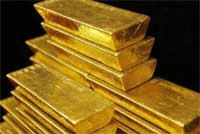Typically, you can estimate the value of gold or its direction depending on the state of the economic climate. Prices usually soar during times of recession and economic austerity. As investors lose their appetite for risk, they look to store their money in the direct ownership of a secure storage of wealth. Conversely, you would expect gold prices to fall during times of prosperity. In these times, demand for gold will fall while investors seek out more liquid options with higher potential returns.
What Factors Impact the Price of Gold?
Market volatility and uncertainty has a direct impact on the price of gold. During these times, the value of gold can be driven down amid a lack of sustained or reliable economic growth. This has been highlighted recently, with the precious metals (gold, silver, platinum) heading towards five-year lows. This is as U.S. dollar values continue to fluctuate wildly. Having recently dipped below the psychologically significant threshold of $1,100 per ounce, there remain fears that the price of gold has yet to reach rock-bottom in 2015.
The Issue with Gold: What near-term Factors will drive Price down?
In the immediate future, the US Federal Reserve will also play a key role in determining the value of gold. More specifically, it is set to meet today to discuss the core elements of the economy, with a particular emphasis on interest rates. While the Federal Reserve tends to manipulate these rates and minimize them in a bid to relieve the pressure during times of economic austerity, it takes the opposite view as the economic climate improves. With the U.S. economy finally showing signs of concerted growth, the Fed will be making the decision whether or not to raise interest rates from their current level of 0.25%.
Raising Interest Rates – Positive or Negative for Gold?
Where Will Gold Value Head in the Next 5 Years? Well, while a raise of interest rates would be largely positive news, the consequences for gold investors could be dire. After all, we have already stated that gold prices tend to decline during times of economic growth. As we discussed earlier, this is because while gold offers a secure store of wealth it generates no returns from regular interest repayments or dividend income. As the investor mind-set changes in line with the economic climate, the lack of a fluid or margin-based return distinguishes gold as a safe, conservative and ultimately unrewarding option.
So a rise in interest rates will likely squeeze the price of gold further down. This is despite the commodity’s underlying value and the long term financial security – particularly during periods of stock market volatility – that it offers to investors. We would therefore expect prices to fall even more in the near-term! This would force the spot price of gold/silver/platinum to drop below the five-year low and drive demand even lower. It is fair to say that the longer-term view of gold’s value is less clear. As a volatile global economy and the ongoing threat of political unrest continues, this may yet undermine future economic growth – this will benefit the value of gold.
Where Will Gold Value Head in the Next 5 Years?
So while it is easy to suggest that gold prices will continue to fall beyond 2015, this depends on a number of factors. With other crucial commodities such as oil also struggling with fluctuating price points and falling demand, for example, the global economy may yet decline considerably in the next 12 months. The impact of the Greek debt crisis can also not be ignored, while the upcoming Presidential election campaign may also create additional instability. The upshot of this is that the Fed may choose to hold or lower interest rates in the future, causing the price of gold and demand for this metal rebound considerably.
Where will gold value head in the next 5 years? It is impossible to know for sure! I recommend that folks hold a bit of gold in their portfolio as an “insurance” to a low probability financial meltdown rather than plan to make it big by investing in gold.









